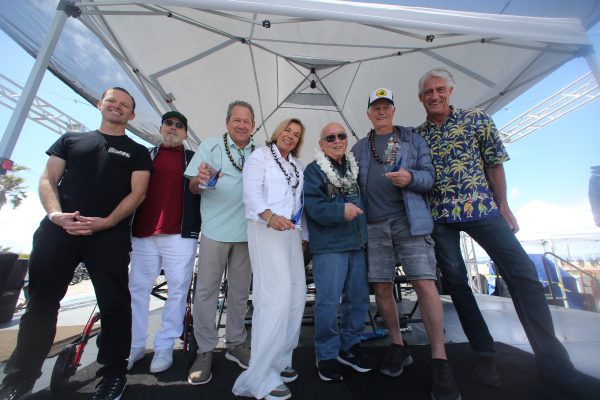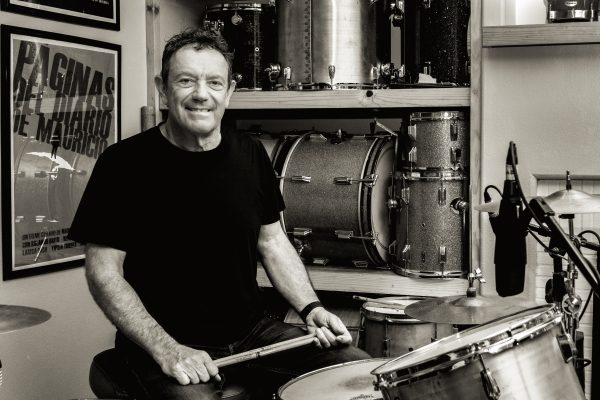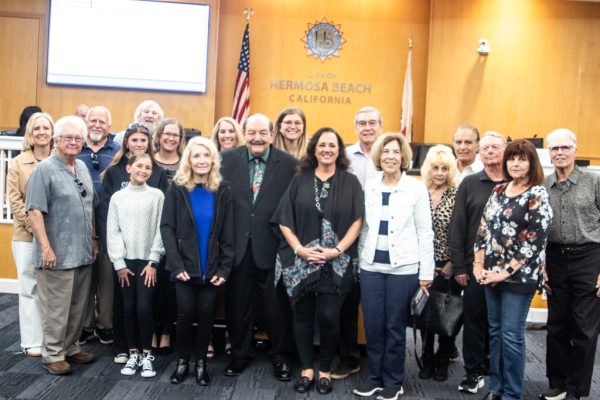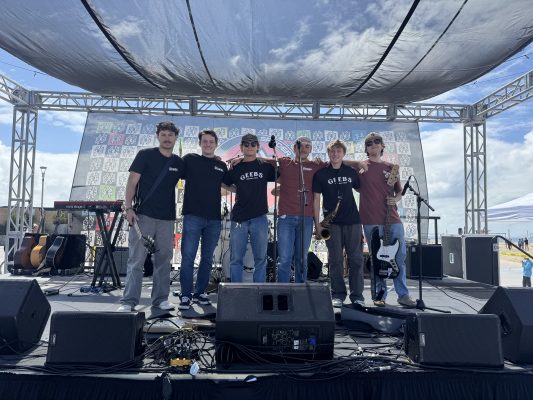
Monsignor Paul Dotson remarked at how pleased his predecessor would have been. As people arrived at the funeral – one of the largest in the history of the South Bay – Dotson said that someone asked him a question.
“What pew do his friends sit in?” the person asked.
“You better look around,” Dotson replied, waving at the entirety of the gathering.

Monsignor Michael Lenihan, known as “Father Mike” to the parishioners of St. Lawrence Martyrs Church who he ardently served for three decades, passed away last Wednesday from complications related to pneumonia. He was 85.
Lenihan is remembered as a tireless advocate for the less fortunate and as a remarkably open-hearted priest whose kinder, gentler approach to matters of the church made it possible for countless lapsed Catholics to return to their faith. Yet Lenihan was a stalwart supporter of the Catholic hierarchy as well, a man whose greatest satisfaction was serving as parish priest but who superiors looked to as an inspiration and a guide.
Cardinal Roger Mahoney, the Archbishop Emeritus of Los Angeles, wrote a letter to St. Lawrence parish last Thursday in which he described Lenihan as one of his “very special advisers and confidantes” who “spent himself fully in service” to his flock.
“He was extraordinary in his commitment, and will long remain in the history of our archdiocese as a fine example of selfless priestly service,” Mahoney wrote.
Lenihan came from the small country parish of BallyMcElligott in County Kerry. The Ireland he knew as a child had not yet emerged from centuries of endemic poverty and disease, and Lenihan did not escape the hardship so common to that time and place. He was the youngest of nine children, and though his family had the relative good fortune of owning a dairy farm, tuberculosis ravaged the Lenihan clan. By 1948, when his oldest brother died from the disease—“the lowest ebb of all,” Lenihan sadly remembered in an interview in 2002 —he had seen three sisters, two brothers and his mother all taken by tuberculosis.
Somehow, in the midst of such sorrow, Lenihan’s faith grew. “Well, it’s the will of God,” he recalled his father often saying as the family persevered through tragedy after tragedy. Lenihan realized as a teenager that he wanted to devote his life to serving others.
“I spent a lot of time growing up going to sanitariums and hospitals,” he said. “I think that may be where my desire to serve came from.”
On June 22, 1952, Lenihan was ordained as priest, and shortly thereafter given his first assignment, a small parish in Alice, Texas. He couldn’t have been more thrilled. “I always wanted to come to America,” he said. ”It was the fulfillment of a dream to live here.”
Lenihan served in Texas for seven years. Ironically, while there he became ill with tuberculosis, and though he escaped the disease through surgery, it became necessary for him to live in another climate. He was sent to California, where he served at a parish in Temple City. After five years, he became pastor at St. Columbkille’s, a poor parish in South Central Los Angeles. It was there he met another young priest, Father Joseph Sartoris, who served in a nearby parish.
“He kind of introduced me to life ministry,” Sartoris remembered in 2002. “I just admire him a great deal. What he did for the poor there—the kids’ educations, the families that needed help just getting food, clothing—was amazing.”
Sartoris eventually ended up in San Pedro, where he served as a regional bishop until his retirement in 2002. But the experience in South Central deeply influenced both priests.
“It’s long, hard work, and you don’t have many resources, but I think those were happy days,” Sartoris said. “It’s pure ministry, not a lot of administration or staff, a much more direct, people-to-people kind of thing. He was very good at it. He just had a true desire to serve, and he was naturally on the side of the underdog. His whole history, and that of his people, was for the little guy who didn’t have an advocate. He was very much into social justice. He moved on to a more affluent community, but he never forgot St. Columbkille’s.”
Sartoris recalled in his homily on Tuesday that Lenihan found an ingenious way to produce revenue for St. Columbkille’s – he ran a world class bingo operation, complete with reserved seating.
“I think it was the envy of Vegas,” Sartoris said, adding with a chuckle. “If it was a little unlawful, it was just a little.”
Lenihan arrived in Redondo Beach in 1981. He was only the second priest in the history of St. Lawrence – which was founded in 1955 by Monsignor Dan Collins – but he quickly became part of the fabric of the community.
“Absolutely right from the get-go he was really just about hospitality with the people and just really being [of] open arms,” said Rene Ayala, the church’s director of worship and music. “He always ended every mass by saying, ‘God love you, and have a wonderful week’ in his brogue style.”
Many of his sayings became well known in the community. Pat Lane, a fellow Irishman who became a very close friend, recalled Lenihan’s constant urging: “Just get out there, get off your arse, and do the work. The people need you.”
Beyond his words – and he was indeed known for his Irish-tinged eloquence – Lenihan is remembered as a man of inexhaustible action.
Former Redondo Beach City Councilman Kevin Sullivan recalled that Lenihan was at St. Columbkille’s during one of the race riots of the 1970s. While many of the white residents of area fled, he and former county supervisor Kenneth Hahn – well known for his civil rights advocacy – went right out into the fray.
“He lived right in the middle of it, right in the epicenter of where the riots were going on,” Sullivan said. “No way was he running away. He and Kenny Hahn went right out into the streets and tried to quell people…He always reached out to everybody.”
In Redondo, Lenihan faithfully rose from bed early every Sunday at 3 a.m. to make the trip to a bakery called Homie’s in East L.A. that is run by Father Greg Boyle and employs former gang members. Lenihan would buy doughnuts, with his own money, to serve to his parishioners after mass later that morning.
“He’d go buy from that group so he could help them,” Lane recalled. “I said, ‘You know, that’s not the best place to be at 3 a.m., you know?’ But every Sunday morning he’d do that.”
Throughout his life, he rose well before dawn to begin his work. After retirement, Lane was in the habit of dropping by his office sometime after 5 a.m. to bring Lenihan the morning papers and have a chat.
“Five a.m. was a late morning for him,” Lane said. “He’d be at his desk praying by then. I’d say, ‘Okay, just fire up another prayer or two for me’….then by 6:15 Mass time, he’d say, ‘Okay, gotta go now, gonna be late…You and I were trained to work – now go do your work.’”
Lenihan’s work ethic was legendary. The year before his retirement in 2003, he’d performed 3,845 baptisms, 2,360 marriages, and 2,269 annulments at St. Lawrence’s. As Sartoris noted in his homily, his retirement was in name only, as his home in the rectory became a “mini-church” where he still sometimes conducted marriages and baptisms. His work with annulments was well-known world-wide – not only his ability to guide couples through the difficult process, but to so in a way that they came away with a deeper commitment to their faith.
Councilman Steve Aspel was one of many parishioners who was brought back to the church through this process.
“He was a master politician,” Aspel said. “He’d marry you, annul you, and marry you again. He wasn’t a Vatican priest…He made it fun to go to church. He was a people’s priest.”
“But he was very serious about your commitment to the church before he’d work on your annulment,” Sullivan said. “You had to be serious.”
Lenihan actively sought out people who’d left the church, sometimes going so far as to run advertisements in local papers welcoming people back and offering classes that reintroduced people to their faith.
“The ads would say, ‘We want you back,’” Sullivan said. “”It was geared to people of my generation who’d been brought up Catholic but had left the church….So many people returned because of Monsignor Lenihan.”
His work behind the scenes was even more legendary. In times of trouble, two words become common throughout his parish: “Call Lenihan.” He sat at bedsides of the ill, counseled the bereaved, and made himself available to anyone at any time of the day or night. One person who asked not to be identified recalled one parishioner who Lenihan had tried for decades to help quit drinking, without success; finally, when the man was in his deathbed, dying of liver failure and in great pain, he would only allow one person to visit: his beloved Father Mike.
Such quiet acts of kindness and mercy were the hallmark of his ministry.
“He was a man of action,” said Eve Moir, the church’s liturgy director. “He was a mover, but he was always helping people in ways that no one saw. He helped so many people and he didn’t need words. He was always there, always present with people. He lived the gospel, and he never needed people to know how wonderful he was. He just was.”
“He was a man who was just totally about his priesthood, and in the truest sense of the word, being a man of service, trying to meet people where they are and fill their needs as best he could,” Ayala said.
Aspel said Lenihan was a “man of the people” who had the rare gift of making everyone he talked to feel like the most important person in the world. “He was a priest, an insurance agent, a Realtor, a riverboat gambler,” Aspel said. “Everybody all rolled into one.”
In 2001, the church elevated Lenihan to the rarely conferred rank of Protonotary Apostolic, signifying the esteem in which he was held by church leadership. Sartoris said that Lenihan, however, had already achieved his life’s highest goal.
“His greatest honor was being a parish priest,” Sartoris said. “I don’t think he ever wanted anything else.”

Lane said that not long before the monsignor’s death, he’d called Lenihan and asked if he could stop by for lunch and bring him some soup. He knew Lenihan had not been feeling well. But his friend was not at home.
“He was out doing things… ‘No, I need to get stuff done,’ he said. He was independent and really wanted to get out there,” Lane said. “I told him you don’t need to be getting out there, you are not feeling well. ‘Oh, I’m fine,’ he said. But he wasn’t fine. He just kept going and going and then they had to put him in the hospital and that was it. He did have a big heart, and that was probably the last thing to go.”
“He made a great difference to people he knew – he made us all better, because he really cared, and he expected that out of us, too,” Lane added. “There is a saying in Kerry: ‘They will never see the likes of us again.’ And that is true. I’ll for sure never see the likes of him again.” ER
Monsignor Lenihan remembered in PHOTOS
See also: Eulogy by Bishop Sartoris











